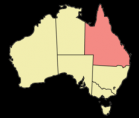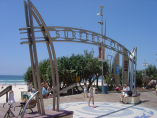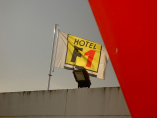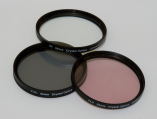introduction

Snowdog: Map of Australia highlighting Queensland; 30 December 2005
Queensland is a state of Australia, that occupies the north-eastern corner of the mainland continent. It has borders with the Northern Territory to the west, South Australia to the south-west and New South Wales to the south. The capital of the state is Brisbane.
The state offers hundreds of kilometres of surfable coastline with direct exposure to the Pacific. North of Brisbane, the Great Barrier Reef starts to shield much of the coastline; surf here exists primarily on the outer reefs and islands. These prospects are only now starting to be exposed as valid surfing destinations - there is a lot of ground still to cover.
surfing

Rocky88: Entrance to Surfers Paradise, Queensland; 2006
Want to surf the superbank? Mkay but don't spend three weeks out of your four week holiday lining up for your shot. The whole QLD coastline from the NSW boarder up to Fraser Island offers quality consistent surf and year round warm water. This coast reads like a who's who of classic surf spots. Kirra, Duranbah, Snapper Rocks, Noosa and the list goes on.
North of Fraser the combination of a generally north north west grading coastline and the fringing Great Barrier Reef reduce regular surfing options considerable. The great barrier reef does offer several excellent offshore passes and breaks for those of spirit all the way to Cairns, but their locations are fiercely guarded by the few that surf them. Still, this should give you plenty to keep yourself busy with.
weather

WxGopher: Air masses, 9 February 2007
Queensland is known as the ‘sunshine state’ for good reason. Even in the winter months the average maximum air temperature remains above 20 degrees celcius. Maximum temperatures in the summer are around 28 degrees, with sub-tropical humidity. Summer is usually the wettest time of year, while winters are generally dry and sunny.
The water temperature varies from approximately 25 degrees in the summer to a pleasant 19 degrees in winter. This means that you can almost get away with boardshorts year round, although most opt for some sort of wetsuit protection in the cooler months to take the edge of the wind.
Summer (December – February)
The most relaible time for favorable surf conditions is the summer months and early autumn. Summer is ‘cyclone season’, with the majority of Tropical Cyclone activity occuring between December and March. These tropical low pressure systems can generate extremely strong winds, which lead to large and powerful swells along the Queensland Coast. These tropical systems can also interact with a subtropical high that is usually located to the south of the state in the summer months. This can lead to an extended period of strong SE winds between New Zealand and Fiji, which can see sustained runs of swell lasting more than 1 week.
Autumn (March – May)
Autumn can still see a number of larger swell events, as deep mid latitude low pressure systems form as the result of colder air moving across the Australian continent before interacting with the warm sea surface off the Queensland Coast. These low pressure systems are often referred to as East Coast Lows (ECL) and are the source of many large swells along the Queenland Coast.
Winter (June – August) and Spring (September – November)
Winter and spring tend to see smaller surf, due to the northward movement of the sub-tropical belt of high pressure, and the associated easing of the regular SE trade wind swells. That being said, conditions will be clean most mornings thanks to offshore W’ly winds created by downslope winds from the hinterland (hills) that lie inland from both the Gold and Sunshine Coasts.
travel

Driving in Australia (from www.wikitravel.org)
There are two common ways of travelling in Australia: by car or by plane. Train can be an option, but not all states have a public rail network. Greyhound Australia provides a nation-wide (except Tasmania) interstate bus service. And there is a car ferry that departs from Melbourne and goes to Devonport in Tasmania.
The country is huge, so if don’t have enough time, take a plane. Fares are generally low, due to the amount of competition, and flights depart regularly. Main business travel corridor is Melbourne-Sydney-Brisbane with flights leaving every 15 minutes. You’ll be able to get to every state with Qantas, Jetstar, Virgin Blue or Regional Express. There also are some small state-based airlines that serve regional areas: Airnorth, Skywest, O’Connor Airlines and MacAir Airlines.
Travelling by car is a great option as well, especially to those who want to see and feel the country from he inside. Australia has a well-maintained system of roads and highways and drives 'on the left'. Keep in mind that great distances separate its cities and after leaving one of them, you can sometimes expect to travel for hours before finding the next trace of civilisation. So it’s a good idea to hire a satellite phone in case of emergency. The shortest distance would be from Sydney to Canberra – just 3-3.5 hours (~300 km). But it is a truly magnificent experience to hire a car and travel around the coast of Australia (check the Great Ocean Road), which you won’t forget.
where to stay

Erwin1990: Flag of Hotel Formule 1; 7 July 2004
Your final decision really depends on your preferences and budget. If you like camping, there are a lot of those in every state of Australia. And there is a great option for those, who still prefers some comfort, but the budget is limited, – Hotel Formule1. These hotels have absolutely the same basic and very clean rooms (for 3 people) in all the cities (so you know what to expect) and can be found in Sydney (NSW), Coffs Harbour (NSW), Melbourne (VIC), Canberra (ACT) and Brisbane (QLD). Rates can start from AU$59.00 per room/per night and conditions are usually better than in the numerous motels along the highways (where you will probably spend about AU$100 per room/per night).
There are nice caravan parks (van/trailer parks) with on site cabins in WA, as well as in most states (usually you will see the signs if you drive on the highway). Prices range from AUS$25.00 to AUS$50.00. They are very comfortable and have cooking facilities and a refrigerator. The extra price will provide you with some more comfort.
Cable Beach Backpackers is another nice place in WA with clean and spacious rooms, bathrooms and kitchens, just a few minutes walk from Cable Beach in Broome. Also try Augusta YHA – a very affordable and clean hostel in a brand new building.
And of course, there are all the luxurious hotels, where you can enjoy the best service. But basically for all the states the rule would be the same – there are numerous motels, hostels, caravan parks and camping sites near the surf spots, so you’ll definitely find something.
what to pack

Rich Niewiroski Jr.: 62 mm ultra-violet, fluorescent, and polarizing lens filters; April 9, 2007
Queensland is a popular wintertime tourist attraction. Just remember even though Surfer's Paradise is known for its all time surfing, it isn't always hot. Remember to bring warm clothing, but also be prepared for those nice hot days, when you can go out for a swim/surf.
A small backpack makes a good carryon bag and will be useful in daily life.
Beach clothing & sandals and a snorkelling gear. And don't forget to take a good protection for your camera from the sand.






